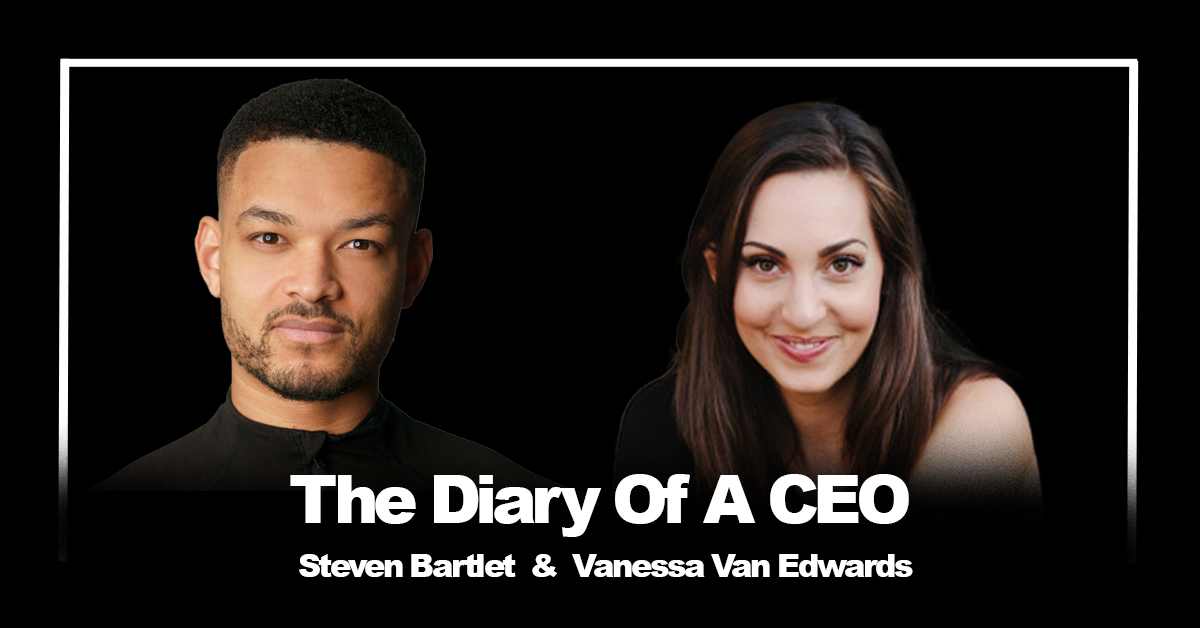This week on The Diary Of A CEO, Steven Bartlett welcomes back Vanessa Van Edwards, a leading expert in human behavior, communication, and cracking the code on social interaction. Vanessa, a self-proclaimed “recovering awkward person,” has helped hundreds of thousands learn the science-backed secrets to better dates, smoother conversations, bigger career wins, and ultimately, a healthier, happier life.
This conversation dives deep into the nuances of personality, first impressions, communication breakdowns (and how to fix them), and the surprising power of understanding nonverbal cues. Vanessa breaks down the ‘Big Five’ personality traits, reveals the biggest mistakes people make when meeting someone new, and offers practical, actionable techniques anyone can use to become a master communicator and build stronger connections – online and in person.
Whether you struggle with awkwardness, want to improve your relationships, or simply wish to understand people better, this episode is packed with valuable insights.
Here are the detailed key insights and takeaways:
1. Personality: Can We Change Who We Are?
- The Big Five Traits (OCEAN): Openness, Conscientiousness, Extraversion, Agreeableness, Neuroticism. Everyone falls somewhere on the spectrum for each.
- Nature vs. Nurture: Research suggests these traits are 42-57% heritable (genetic). Neuroticism (worry) has links to serotonin production.
- Potential for Change (30-40%): While you can’t completely flip from low to high on a trait, there’s significant room (30-40%) to purposefully “dial up” or “dial down” aspects through conscious effort, habits, and mindset shifts. If you want a better relationship, promotion, or more friends, change is possible.
2. Nailing the First Impression (It Happens Faster Than You Think!)
- Accuracy: First impressions are surprisingly accurate (around 76%) in gauging core personality traits like extraversion and agreeableness (neuroticism is hardest to spot).
- Speed: Impressions form within the first 100 milliseconds of seeing someone, especially online profile pictures. Different photos of the same person elicit different judgments.
- Biggest Mistake: Looking down (at phone, notes, etc.). This signals the universal “defeat posture” (tucked chin, closed-off body) and makes you look like a “loser” (in the losing/winning sense).
- What Works: Open body language, visible hands (builds trust), direct eye contact (aim for 60-70% in Western cultures), genuine smiles (activating upper cheek muscles), and being angled towards the person.
3. Beyond the Basics: Advanced Communication Cues
- The Triple Threat: In video calls, having your camera aligned so you can easily look at the lens (eye contact) and the person’s image, with good posture.
- Break the Script: Avoid the generic “How are you?” / “Good, busy” loop. Ask more engaging questions (“What’s been good?”, “What are you looking forward to?”) or share a unique, positive micro-anecdote to spark genuine conversation.
- Gift Good Chemicals: Master communicators make others feel good. Aim to gift:
- Dopamine (excitement, motivation): Share interesting facts, ask engaging questions.
- Testosterone (capability, feeling smart): Compliment competence, validate ideas.
- Serotonin (calm, belonging): Show warmth, create safety, affirm (“Join the club,” “Thread me too” on shared interests).
- Conversation Cues: Use background elements (bookshelves, art on Zoom) as “gifts” or conversation starters for others.
- The Power of Touch (Appropriately): Handshakes (firmness, length) reveal personality. High fives, fist bumps, or even a light arm touch (context is key) can build connection.
- Smelling Hands?: Bizarre but true research shows we unconsciously tend to touch our face/nose after shaking hands, potentially “smelling” the other person’s chemical signals.
4. Building Deeper Connections: Beyond Surface Level
- Core Friendship Values: Define what truly matters to you in a friendship (e.g., Vanessa values Respect, Self-Honesty, Depth). Understanding your values helps you filter for compatible people.
- Identify Your Blocks: Reflect on past friendships that fizzled. What was missing? What drives you crazy about current friends? This reveals your core needs.
- Show Your Liking: Loneliness often stems from withholding our liking. Make it obvious (verbally and nonverbally) when you appreciate someone or something they do/say. Affirm the positive adjective (“That is interesting/funny/insightful”).
- Be the Best Passenger: If you’re not naturally funny, be an appreciator of humor. Laugh readily, “hype up” funny people – it makes them feel good and makes you more likable. Curate and share funny things.
- Second Impressions: If the first was shaky, your best bet is to show the person they were on your mind (“I really enjoyed our last chat,” “I’ve been looking forward to this”).
5. Online Impressions & The “Red Apple” Effect
- Stand Out: Online communication (DMs, emails) is noisy. Use a unique opening word/phrase (“Howdy,” “Aloha,” “Bingo!”) instead of “Hi/Hello” to be the “red apple” that grabs attention.
- Video Calls: Camera ON (at least initially). Ensure good lighting, angle your body towards the camera, keep hands visible, and use your background intentionally (conversation cues!). Avoid fake/blurred backgrounds (perceived as inauthentic).
6. Personality Nuances & Longevity
- Conscientiousness & Extraversion: High conscientiousness (detail-oriented, reliable) and high extraversion (enjoys social interaction, builds support systems) correlate with living longer.
- Neuroticism: High neuroticism (worry) correlates with shorter lifespan due potentially to chronic stress and slower serotonin response. Working on resilience and dialing down worry is key.
- Agreeableness: High agreeableness can lead to overcommitting and burnout; low agreeableness can make collaboration difficult. Balance is needed.
- Openness: High openness loves novelty (adrenaline junkies); low openness prefers routine/tradition. Matching levels is helpful in relationships.
Final Thought:
Vanessa Van Edwards provides a toolkit for navigating the human landscape with more skill and confidence. By understanding the science of perception, decoding nonverbal cues, and communicating with greater intention and warmth, we can improve our first impressions, build deeper connections, and unlock more success and happiness in every area of life. It starts with awareness and the courage to break old patterns.
Find Vanessa: Learn more about Vanessa Van Edwards, her books (Captivate, Cues), courses, and take her personality quiz at ScienceOfPeople.com.
Until next time,
The Podcast Notes Team





